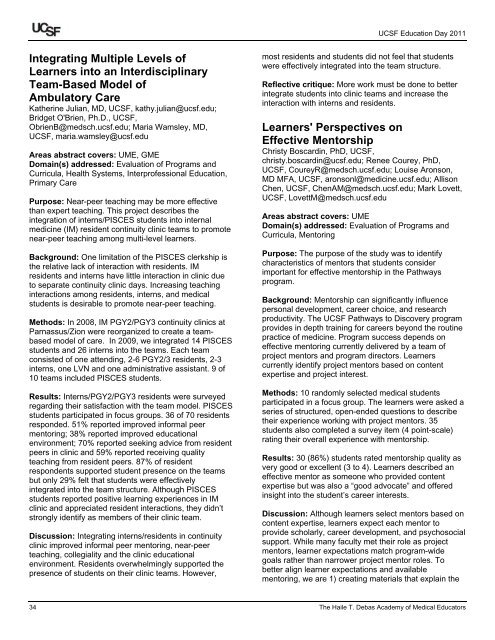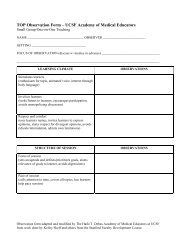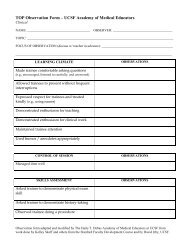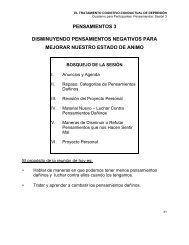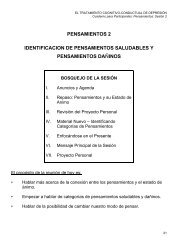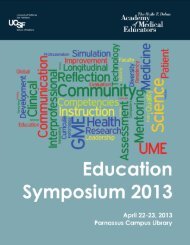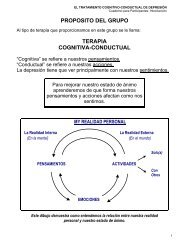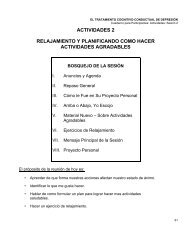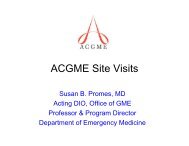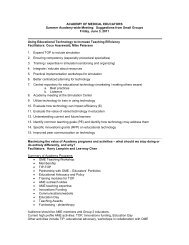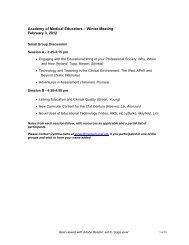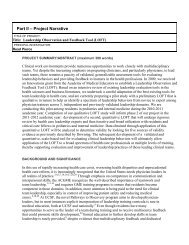2011 - UCSF School of Medicine - University of California, San ...
2011 - UCSF School of Medicine - University of California, San ...
2011 - UCSF School of Medicine - University of California, San ...
Create successful ePaper yourself
Turn your PDF publications into a flip-book with our unique Google optimized e-Paper software.
<strong>UCSF</strong> Education Day <strong>2011</strong>Integrating Multiple Levels <strong>of</strong>Learners into an InterdisciplinaryTeam-Based Model <strong>of</strong>Ambulatory CareKatherine Julian, MD, <strong>UCSF</strong>, kathy.julian@ucsf.edu;Bridget O'Brien, Ph.D., <strong>UCSF</strong>,ObrienB@medsch.ucsf.edu; Maria Wamsley, MD,<strong>UCSF</strong>, maria.wamsley@ucsf.eduAreas abstract covers: UME, GMEDomain(s) addressed: Evaluation <strong>of</strong> Programs andCurricula, Health Systems, Interpr<strong>of</strong>essional Education,Primary CarePurpose: Near-peer teaching may be more effectivethan expert teaching. This project describes theintegration <strong>of</strong> interns/PISCES students into internalmedicine (IM) resident continuity clinic teams to promotenear-peer teaching among multi-level learners.Background: One limitation <strong>of</strong> the PISCES clerkship isthe relative lack <strong>of</strong> interaction with residents. IMresidents and interns have little interaction in clinic dueto separate continuity clinic days. Increasing teachinginteractions among residents, interns, and medicalstudents is desirable to promote near-peer teaching.Methods: In 2008, IM PGY2/PGY3 continuity clinics atParnassus/Zion were reorganized to create a teambasedmodel <strong>of</strong> care. In 2009, we integrated 14 PISCESstudents and 26 interns into the teams. Each teamconsisted <strong>of</strong> one attending, 2-6 PGY2/3 residents, 2-3interns, one LVN and one administrative assistant. 9 <strong>of</strong>10 teams included PISCES students.Results: Interns/PGY2/PGY3 residents were surveyedregarding their satisfaction with the team model. PISCESstudents participated in focus groups. 36 <strong>of</strong> 70 residentsresponded. 51% reported improved informal peermentoring; 38% reported improved educationalenvironment; 70% reported seeking advice from residentpeers in clinic and 59% reported receiving qualityteaching from resident peers. 87% <strong>of</strong> residentrespondents supported student presence on the teamsbut only 29% felt that students were effectivelyintegrated into the team structure. Although PISCESstudents reported positive learning experiences in IMclinic and appreciated resident interactions, they didn’tstrongly identify as members <strong>of</strong> their clinic team.Discussion: Integrating interns/residents in continuityclinic improved informal peer mentoring, near-peerteaching, collegiality and the clinic educationalenvironment. Residents overwhelmingly supported thepresence <strong>of</strong> students on their clinic teams. However,most residents and students did not feel that studentswere effectively integrated into the team structure.Reflective critique: More work must be done to betterintegrate students into clinic teams and increase theinteraction with interns and residents.Learners' Perspectives onEffective MentorshipChristy Boscardin, PhD, <strong>UCSF</strong>,christy.boscardin@ucsf.edu; Renee Courey, PhD,<strong>UCSF</strong>, CoureyR@medsch.ucsf.edu; Louise Aronson,MD MFA, <strong>UCSF</strong>, aronsonl@medicine.ucsf.edu; AllisonChen, <strong>UCSF</strong>, ChenAM@medsch.ucsf.edu; Mark Lovett,<strong>UCSF</strong>, LovettM@medsch.ucsf.eduAreas abstract covers: UMEDomain(s) addressed: Evaluation <strong>of</strong> Programs andCurricula, MentoringPurpose: The purpose <strong>of</strong> the study was to identifycharacteristics <strong>of</strong> mentors that students considerimportant for effective mentorship in the Pathwaysprogram.Background: Mentorship can significantly influencepersonal development, career choice, and researchproductivity. The <strong>UCSF</strong> Pathways to Discovery programprovides in depth training for careers beyond the routinepractice <strong>of</strong> medicine. Program success depends oneffective mentoring currently delivered by a team <strong>of</strong>project mentors and program directors. Learnerscurrently identify project mentors based on contentexpertise and project interest.Methods: 10 randomly selected medical studentsparticipated in a focus group. The learners were asked aseries <strong>of</strong> structured, open-ended questions to describetheir experience working with project mentors. 35students also completed a survey item (4 point-scale)rating their overall experience with mentorship.Results: 30 (86%) students rated mentorship quality asvery good or excellent (3 to 4). Learners described aneffective mentor as someone who provided contentexpertise but was also a “good advocate” and <strong>of</strong>feredinsight into the student’s career interests.Discussion: Although learners select mentors based oncontent expertise, learners expect each mentor toprovide scholarly, career development, and psychosocialsupport. While many faculty met their role as projectmentors, learner expectations match program-widegoals rather than narrower project mentor roles. Tobetter align learner expectations and availablementoring, we are 1) creating materials that explain the34 The Haile T. Debas Academy <strong>of</strong> Medical Educators


